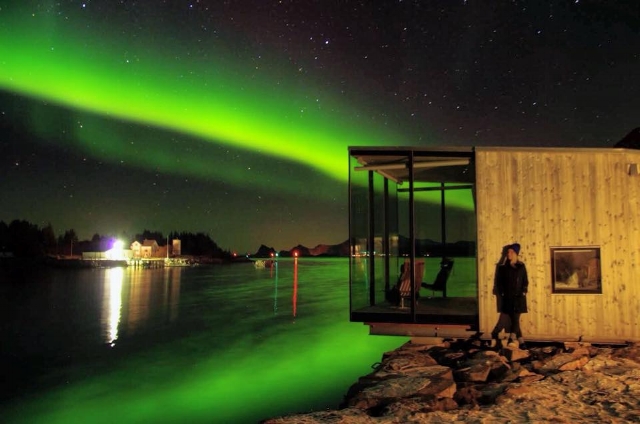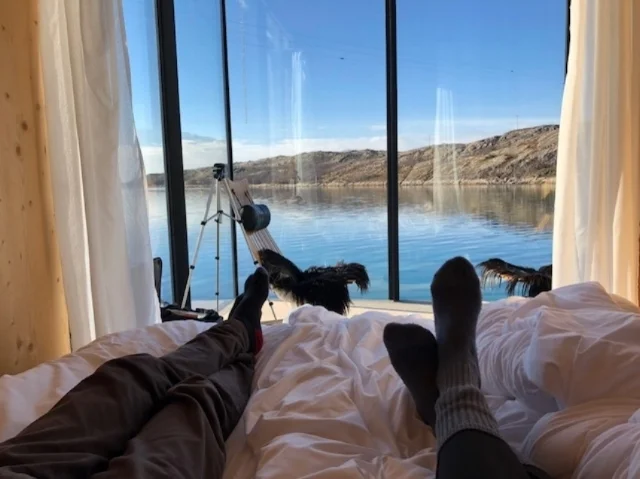“Exactly HOW good are they?” I shouted out the window from bed, as I lazily rolled from side to side, fighting off post-dinner lethargy. “Do you see any purple? Are they extra squiggly?”
If you’ve seen them before, you know that the northern lights seem to have two extremes: 1) a light green hue in the sky - faint, but visible to the human eye, and 2) ABSOLUTE UNEXPECTED CHAOS; when the lights start to dance and vertical lines emerge from the black of night in such a way that purples and pinks surface in waves. In this stage, virtually anything can happen - and no two experiences are ever the same.
You know you’ve reached peak Northern Lights snobbery when you become arbiter of which lights are worth leaving the cabin for. But after freezing my fingers off photographing impeccable auroras the prior night, a light hint of green beams reflecting across the channel just wasn’t enough to justify emerging from the balminess of the indoors.
Luckily, Manshausen Island is one of the only places in the world where you don’t have to choose between comfort and auroras. The island, situated 100 km above the Arctic Circle, contains only four cabins (soon to be seven, as new ones are in development) jutting out into the Grøtøya strait, each with floor to ceiling glass windows, from which you can take in the lights (or sunrise/sunset).
Manshausen is run by a lovely young couple: Astrid and Jesper, who moved to the island together as their own personal adventure only last year. These forces of humans are as important to the island as the land itself. She cooks, organizes, handles guests – you name it. He – a former mountain guide – does the other half of the duties. Partners in the truest sense, they have unmistakably made Manshausen their home and have become one with the place. And it’s contagious: while there, you feel as though you should too.
During the day, you are encouraged to do your own exploring or take part in one of the activities available: kayaking, hiking on the adjacent island, fishing for some arctic catch, or even just walking around the Manshausen Island itself can keep you busy for an afternoon. There are many fun finds on the island itself: the resident sheep population, seashells, and sunrises/sunsets which you'll remember for a lifetime. After a day of adventuring, you can either cook for yourself in your own cabin, or opt into an incredible meal with only the best ingredients sourced from the surrounding islands.
The supreme immersion and belonging to everything local is exactly what I imagine the founder Børge Ousland had in mind when he came up with the idea to open Manshausen in the far reaches of northern Norway.
A highly esteemed polar explorer, Børge spent years looking for a way to share the immense beauty of arctic landscapes which he had come to love with normal folk. Quite the quest, coming from a guy who said his marital vows at the North Pole.
The search for such a place turned out to be an adventure in itself. Børge didn’t find Manshausen overnight. It took years of travel, a bit of luck, a chance meeting with the eventual architect, and some convincing – as any new venture usually does. But throughout, Børge’s paramount aspiration was to create a place where humans and nature could exist in harmony.
Minutes after an Arctic seal surfaced in the water right underneath our cabin, I watched one of the largest sea eagles imaginable soar overhead. I looked out at the Lofoten Islands in the distance, and inhaled the Barents Sea. Did Børge succeed? You decide.





























